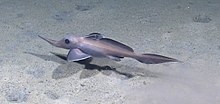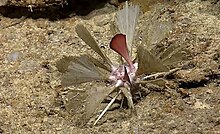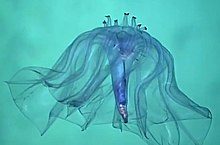Okeanos Explorer
|
Okeanos Explorer with the satellite dome over the bridge
|
||||||||||||||||||||||||||||
|
||||||||||||||||||||||||||||
|
||||||||||||||||||||||||||||
|
||||||||||||||||||||||||||||
|
||||||||||||||||||||||||||||
|
||||||||||||||||||||||||||||
The Okeanos Explorer is a research ship of the National Oceanic and Atmospheric Administration (NOAA), which was officially launched in 2010 .
description
Originally the Stalwart-class ship was built for the United States Navy under the name Capable as a reconnaissance ship and put into service on June 9, 1989. On September 14, 2004, it was handed over to NOAA. The ship was renamed after Okeanos , the ancient Greek god of the sea.
The ship's crew consists of 21 people, plus six NOAA officials. There is space for 19 scientists on board.
The 68-meter-long converted ship is equipped with cameras for high-resolution images and sophisticated equipment such as 3-D sonar mapping systems. The cameras provide real-time observation of the ocean floor for scientists and the public. This is a pioneering work for what NOAA calls telepresence technology . The Okeanos Explorer is the only US government ship dedicated to exploring the ocean floor and the oceanic crust .
The Okeanos Explorer is the only NOAA ship that has a remote controlled vehicle (ROV) permanently on board, unlike other NOAA ships that hand over the ROV at the end of their missions. This makes it easier to use the ship at any time and at short notice. On the Okeanos Explorer there is an integrated control room for the operation of multi-beam, ROV and remote presence communication devices. Since the screens and computers are permanently attached to the ship, it makes long-term explorations into remote areas of the world more efficient. The ship is equipped with a conspicuous satellite dome with a diameter of 3.7 meters, which is installed on a mast.
Research trips
INDEX 2010 survey in Indonesia

From June to August 2010, an international team of scientists from the US and Indonesia worked together to explore the depths of Indonesian waters. The expedition, Indonesia-USA deep-sea expedition in the region between the Talaud and Sangihe Islands (INDEX 2010), showed a number of premieres, including: the maiden voyage of the Okeanos Explorer , the first joint Indonesia-USA-ocean exploration Expedition and the first joint international two-ship mission broadcasting live video to scientists at an exploration command center on land.
Expedition to the Galapagos Rift Valley 2011

From June to July 2011, a team of scientists and technicians conducted exploratory studies both at sea and on land on the diversity and distribution of deep-sea habitats and marine life in the vicinity of the Galapagos Islands . The 50-day expedition was split into two parts ( legs ) and included work in Ecuador , Costa Rica and international waters . While in Part 1 ( Leg I ) the focus was on mapping and obtaining information on the water column, Part 2 ( Leg II ) focused on the identification and exploration of a number of exciting destinations with the ROV. Between July 11 and July 28, 2011, the ship explored seamounts, off-axis sulphide mounds, deep fracture zones and newly discovered vents. On this expedition, a new camera slide and lighting stage called Seirios came for the first time . When the Little Hercules was dispatched from the ship , the very first video footage from a number of deep-sea areas around the Galapagos was available to scientists and the onshore audience.
Expedition to the Mid-Cayman-Rise 2011
In August 2011, the NOAA ship Okeanos Explorer embarked on an expedition to the deepest part of the Caribbean Sea , where a team of international scientists carried out interdisciplinary studies both at sea and on land of the Mid-Cayman Rise - an extremely slow spreading center where two Gradually move the plates apart, throwing up magma , creating new crust and the adjacent Cayman trough. The expedition focused on the oceanic core complexes that dominate the construction of the rift valley walls along much of the Mid Cayman Rise and the inner wall of the Cayman Trough Demolition Zone immediately to the north - studying the geology, marine life, and the hydrothermal systems that drive them Areas could accommodate. Within ten days, the ship had mapped the trench valley walls of the Mid Cayman Rise and the north face of the Cayman Trough Fracture Zone with on-board deep-sea water multi-jet sonar and was exploring the water column for hydrothermal activity using a CTD rosette , in situ sensors and an on-board methane analysis . Furthermore, a detailed investigation of the ocean floor was carried out with the ROV. During the expedition, live video of ongoing operations was broadcast ashore, where a team of scientists from the United States and the United Kingdom were remotely controlled using remote presence technology.
Veatch Canyon test drive 2012
"EX1201" was the first expedition of the 2012 season for the NOAA ship Okeanos Explorer . The main objective of this trip was to operationally test the ship, its systems and all mission equipment. A secondary objective was the use of the ship's technologically advanced multi-beam sonar to explore three northeast and mid-Atlantic canyon areas to underpin and support the identification of the Benthal habitat and efforts to manage NOAA's Northeast Fisheries Science Center (NEFSC). After leaving the home port of Davisville on Rhode Island on February 14, 2012, the Okeanos Explorer went to Veatch Canyon close to the coast, where a test area was probed to ensure the correct calibration of the multi-beam echo sounder. As part of the test run, around 280 square kilometers of Veatch Canyon were completely surveyed bathymetrically , including a large part of the priority 1 area designated by the NEFSC. At a later date, research focused on the Block, Ryan, and McMaster Canyons. It measured around 900 square kilometers of seabed, including 65 percent of the priority 2 area marked by the NEFSC. Finally, the ship mapped 1,400 square kilometers of seabed in the Hendrickson, Toms and Berkeley canyons, including 85 percent of the priority 3 area designated by the NEFSC. During the passage along the continental shelf , the ship collected multi-beam, single-beam and subsurface sonar data between the focused mapping areas, added it to the seabed maps. In addition to the successful test drives and mapping work, the "EX1201" also had a number of positive educational results. During the test drive, two university graduates were trained as part of an internship. In addition, an estimated 50 high school students, educators, and local media traveled to the ship and learned through this expedition in Charleston , South Carolina after graduation .
2012 expedition to the Gulf of Mexico

From March to April 2012, a team of scientists and engineers conducted exploratory studies both at sea and on shore into the diversity and distribution of deep-sea habitats and marine life in the northern Gulf of Mexico . The 56-day expedition was divided into three parts ( legs ). Through discussions and information based on the “Atlantic Basin” working meeting of May 2011, the mapping expedition of the Gulf of Mexico from fall 2011 and Part 1 ( Leg I ) and the Gulf of Mexico expedition from 2012, the NOAA and the broader scientific community a number of exciting goals that they then explored during Part 2 ( Leg II ) and 3 ( Leg III ). Were researched cold seeps , deep coral communities, underwater canyons and shipwrecks . The remote-controlled vehicle (ROV) including the camera sled and the lighting stage returned to the NOAA ship Okeanos Explorer . When these systems were deployed from the ship, real-time video footage from the deep-sea areas of largely unknown US waters could be made available to scientists and the onshore audience.
Expedition to the Northeastern US Canyons 2013

From July to August 2013, a team of scientists and technicians conducted exploratory studies both at sea and on shore into the diversity and distribution of deep-sea habitats and marine life along the Northeast US canyons and the Mytilus Seamount , which are within the exclusive economic zone the USA is located. The 36-day expedition consisted of two trips ( legs ). The exploration area for this community-based expedition was determined based on discussions and information based on the May 2011 Atlantic Basin workshop and the priority area specifications from other NOAA programs and the administrative community. Using these guidelines and data obtained during the previous Atlantic Canyon Submarine Mapping Expedition ( ACUMEN project ), NOAA and the wider scientific community have identified a number of exciting destinations for exploration during the second voyage. In the weeks that followed, the ship explored cold seas, deep coral communities, underwater canyons, properties in landslides, and a seamount. On this expedition, the new 6,000 meter ROV along with a new camera slide and light platform were used for the first time.
Our Deepwater Backyard : Exploring the Atlantic canyons and deep sea mountains 2014
From August to October 2014, the NOAA ship Okeanos Explorer explored the previously unknown deep-sea ecosystem off the US Atlantic coast. The Sea and Shore Science Team collected baseline data in the undersea canyons along the New England Seeberg Range.
Océano Profundo 2015 : Exploring the seamounts, deep sea and mules off Puerto Rico

The second of three explorations by the NOAA ship Okeanos Explorer took place in the Caribbean in 2015. The main focus of this trip was high resolution mapping of areas near Puerto Rico and the Puerto Rico Trench .
2016 Hohonu Moana : Exploring the deep waters off Hawaii

From February 25 to March 18, 2016, the scientists continued the efforts of the Hohonu Moana Expedition to explore deep-sea habitats, which began in 2015 . These took place around the Papahānaumokuākea Marine National Monument . The expedition included work on seamounts in the undersea mountains in the Central Pacific, en route to the port of Kwajalein Atoll .
Expedition 2017 to American Samoa: Suesuega o le Moana o America Samoa

From February to April 2017, NOAA and its partners are conducting two telecurrent scouting trips on the ship Okeanos Explorer to collect critical basic information from unknown and poorly known deep-water areas off American Samoa and Samoa . The focus was, with an emphasis on the Rose Atoll Marine National Monument , the National Marine Sanctuary of American Samoa, and the National Park of American Samoa .
education
NOAA tries to provide data for students, teachers, and anyone else interested. To this end, she is partnering with the San Francisco Exploratorium to develop an online educational program with live broadcasts for all ages and for the general public. The Okeanos Explorer is designed as an educational element that can be followed on Twitter .
literature
- Okeanos Explorer: A New Paradigm for Exploration. In: oceanexplorer.noaa.gov. National Oceanic and Atmospheric Administration, accessed August 9, 2009 .
- NOAA Ship Okeanos Explorer. In: moc.noaa.gov. National Oceanic and Atmospheric Administration, archived from the original on December 14, 2009 ; accessed on August 9, 2009 .
- NOAA Ship Okeanos Explorer Education Materials Collection. In: oceanexplorer.noaa.gov. National Oceanic and Atmospheric Administration, accessed August 18, 2009 .
Web links
- Official website of the NOAA ship Okeanos Explorer (English)
- Official website for the 2016 Deepwater Exploration of the Marianas u. a. with video from a dive to a wreck of a B-29 bomber (English)
Individual evidence
- ↑ a b New high-tech ship will take ocean exploration to new, amazing depths. In: www.mercurynews.com. Retrieved August 9, 2009 .
- ↑ Catalina Martinez: The Evolution of Telepresence Technology. In: oceanexplorer.noaa.gov. NOAA Office of Ocean Exploration, accessed August 9, 2009 (Official Website).
- ^ Telepresence Technology - Office of Ocean Exploration and Research. In: explore.noaa.gov. National Oceanic and Atmospheric Administration, archived from the original on August 22, 2009 ; accessed on August 9, 2009 .
- ^ A b Water Column Sonar Data. NOAA collects and uses active acoustic (or sonar) data for a variety of mapping requirements. In: ngdc.noaa.gov. National Oceanic and Atmospheric Administration, accessed May 5, 2017 .
- ^ Examiner Staff: NOAA gets creative with Exploratorium. In: sfexaminer.com. Examiner, July 23, 2009; archived from the original on August 9, 2009 ; accessed on August 9, 2009 : "A news release from the two organizations explained the venture will join the scientific expertise and observational resources of the NOAA with the creativity and educational expertise of the Exploratorium for a five-year program."
- ↑ Official website. In: oceanexplorer.noaa.gov. National Oceanic and Atmospheric Administration, accessed August 10, 2009 .
- ^ NOAA, Ocean Explorer (oceanexplorer). In: http://twitter.com/ . Twitter, accessed August 10, 2009 .



